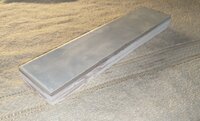- Thread starter
- #921
Slash McCoy
I freehand dog rockets
Of course. .1u is about 200k grit. .25u is somewhere in the neighborhood of 100k. .5u is around 50k grit. Will you like it? Will it be worth the extra work to get a 200,000 grit edge instead of a 20k edge? Probably, but you will know for sure when you have tried both.I currently do the balsa after a Naniwa 12k. I'm waiting for a Suehiro Gokumyo 20k to arrive. Will I still see a significant benefit from the balsa after the 20k?

